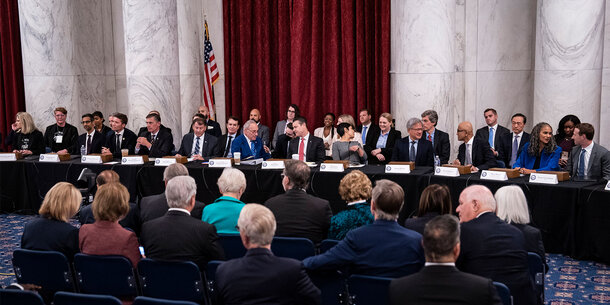Why Countering Violent Extremism Programs Are Bad Policy
In the aftermath of deadly white supremacist attacks, a destructive counterterrorism program is being rehabilitated.

After a white supremacist gunman walked into a crowded Walmart and killed 22 people in early August, Democratic presidential candidates and members of Congress have made addressing white nationalist terrorism a priority for federal law enforcement. This is a necessary and welcome development considering this threat hasn’t been taken seriously enough by federal, state, or local law enforcement across the nation. Unfortunately, many of the policy and legislative proposals would strengthen directly and indirectly a counterterrorism framework known as countering violent extremism (CVE).
While federal law enforcement agencies involved in CVE paint the program as a community outreach initiative dedicated to stopping people from becoming violent extremists, the reality is that these programs, which are based on junk science, have proven to be ineffective, discriminatory, and divisive. Here’s what you need to know about the dangers of CVE programs and why the framework should be abandoned rather than rehabilitated.
What is the countering violent extremism program?
CVE is a counterterrorism strategy that recruits community leaders, social workers, teachers, and public health providers ostensibly to assist the government in identifying individuals that may be “at risk” of becoming violent extremists. But the idea that there are predictive risk indicators has been discredited by decades of scholarly research. They have been targeted almost exclusively at Muslims and employ spurious criteria, such as religiosity and political activism and vague feelings of alienation, as proxies for violent tendencies.
CVE has been around for several years, involving a variety of programs led by federal prosecutors, the FBI, and Department of Homeland Security. While these agencies often present the strategy as a “soft” approach to counterterrorism, internal agency documents obtained by the Brennan Center and others reveal that they often mask efforts to gather intelligence, identify individuals who are not suspected of wrongdoing for surveillance, recruit informants, and co-opt community leaders to promote government messaging. These goals are hidden behind the language of community outreach.
Though CVE programs have been in place for many years, no evidence demonstrates that they are effective in reducing terrorist violence or even the spread of “extreme” ideas. And contrary to the stated goals of these programs to strengthen community resilience, they have proven to be discriminatory in practice and stigmatizing, divisive, and destructive to the communities they target.
CVE programs were built on top of a disproven theory
CVE programs are designed around the erroneous idea that there is a discernible process of radicalization that results in terrorist violence. The key assumption of radicalization theory is that individuals who adopt “extremist” ideologies start down a conveyor belt that leads inexorably toward becoming a terrorist.
While this proposition may have some intuitive appeal, decades of empirical research disproves it. Many people hold views that can be described as “extreme” and never support or commit an act of violence based on those beliefs. And many who commit terrorist violence have little or no attachments to an extreme ideology.
As counterterrorism scholar and former CIA officer Marc Sageman stated, “Despite decades of research, . . . we still do not know what leads people to engage in political violence.” Moreover, ideas that once seemed extreme, such as women’s suffrage and civil rights for all, were necessary drivers of social progress. Suppressing violence is a laudable government goal. Suppressing ideas that don’t meet government approval is not.
CVE programs based on this flawed radicalization theory routinely flag innocent behavior, such as mistrust of law enforcement and feelings of alienation, as indicators of “pre-terrorism.” In a May 2014 document, “Countering Violent Extremism: A Guide for Practitioners and Analysts,” the National Counterterrorism Center developed a questionnaire for police, social workers, and teachers to rank members of the communities they serve on a scale of one to five in categories like “Connection to Group Identity (Race, Nationality, Religion, Ethnicity)” and “Expressions of Hopelessness, Futility.”
Vague indicators like these are meaningless predictors of terrorist violence and turn normal human experiences into suspicious behaviors that will potentially brand innocent individuals as possible terrorists. Not surprisingly, there is no evidence that CVE programs reduce terrorism. In April 2017, the Government Accountability Office published a critical report evaluating federal CVE efforts.
“The federal government does not have a cohesive strategy or process for assessing the overall CVE effort,” the report warned, stating that its investigators could not “determine if the United States is better off today than it was in 2011 as a result of these tasks.”
CVE programs target Muslims despite the persistent threat of far-right domestic terrorism
Government public-facing descriptions of CVE are almost always ideologically and religiously neutral, but the overwhelming focus has always been on American Muslim communities. This is more than problematic as CVE programming reinforces false Islamophobic notions that Muslim Americans pose a grave threat of terrorism. Since 9/11, multiple studies show that far-right terrorists commit more attacks and kill as many people as any other terrorist movements.
Nevertheless, during the Obama administration, the federal government awarded 31 CVE grants totaling $10 million, with only one going to a group that even partially focused on far-right violence. More than half of that $400,000 grant was to be directed toward identifying and deradicalizing so-called “jihadist” extremists. The incoming Trump administration canceled that grant along with other Obama-era grants. Trump administration officials also made the program’s prejudice overt when a member of the president’s transition team in 2016 floated the idea of renaming the program, “Countering Radical Islam” or “Countering Violent Jihad.”
Furthermore, 85 percent of CVE grants administered during the Trump era explicitly targeted minority groups, including Muslims, LGBTQ Americans, Black Lives Matter activists, immigrants, and refugees, according to Brennan Center analysis of the grants. More than half of CVE programs now focus on schools and students, in some cases as young as 5 years old.
CVE programs are Trojan horses
CVE programs are surveillance and intelligence programs masquerading as community outreach programs. Although the Department of Homeland Security currently reports that “CVE efforts do not include gathering intelligence or performing investigations for the purpose of criminal prosecution,” internal government documents say otherwise.
According to a document unearthed by the Brennan Center, the FBI’s own CVE office describes its approach as designed to “strengthen our investigative, intelligence gathering, and collaborative abilities to be proactive in countering violent extremism.”
Surveillance and intelligence gathering even extends to young children and teenagers in schools. In early 2016, the FBI launched a CVE program targeting schoolchildren. It included an interactive website, “Don’t Be a Puppet,” to teach children about violent extremism, with the goal of turning teachers and students into government spies, monitoring one another for tell-tale expressions of unorthodox ideas.
In August 2016, the American Federation of Teachers formally objected to the FBI’s “Don’t Be a Puppet” CVE program. The nation’s second largest teacher’s union described the program as “ideological profiling and surveillance,” particularly of Middle Eastern and Muslim students, that will have a “chilling effect on our schools and immigrant communities, jeopardizing children’s sense of safety and well-being and threatening the security and sense of trust of entire communities.”
In community centers, places of worship, and schools, for example, CVE provides an excuse and a tool to surveil Americans whose only crime is belonging to a group that faces discrimination. This is a counterproductive approach to counterterrorism that stigmatizes and alienates targeted communities and sows distrust of law enforcement.
CVE programs jeopardize fundamental rights
It’s understandable that Democratic presidential candidates and members of Congress would want to do something to address white nationalist terrorism, but CVE is neither effective nor can it be squared with fundamental individual rights.
The counterterrorism framework always risks associating “extremist” ideas, a subjective and nebulous concept, with violence, thereby stigmatizing and delegitimizing innocent people in ways that touch on First-Amendment protected activity. For instance, in 2017, journalists revealed that the bureau had created a category of possible terrorists labeled “Black Identity Extremist” for a movement that didn’t exist and connected it to the First Amendment-protected activity of Black protesters against police violence.
American Muslims, however, have been the disproportionate victims of law enforcement suspicion and surveillance based on vague and meaningless terrorism indicators that implicate foundational American freedoms. In 2014, the Justice Department gave $500,000 to a nonprofit organization in Montgomery County, Maryland. The program’s mission was to identify American Muslims vulnerable to becoming terrorists. Its “potential risk factors” included “political grievances” and “ideology, beliefs and values,” all expressions and beliefs protected by the First Amendment. And in Boston, the Massachusetts Office of Public Safety and Security, a 2016 CVE grantee, listed criticism of U.S. foreign policy as a terrorism indicator.
This shouldn’t be surprising considering the federal government routinely fails to abide by its own rule that that rights protections must be baked into the grants they approve. In the Brennan Center’s analysis of 26 Trump-era CVE grants, 14 grantees never mention how their program will address privacy, civil rights, and civil liberties concerns. Of the 12 that do, only six indicate the safeguards they would put in place to respect fundamental rights. Not one of the six, however, specify the safeguards they would institute to protect individuals from rights violations.
CVE programs fail because they focus on suppressing ideas, rather than reducing violence. With more than half of the violent crimes committed in the United States going unsolved each year, law enforcement resources should not be wasted on CVE programs that have proven to be ineffective and discriminatory in practice.
(Image: Sandy Huffaker/Getty)




